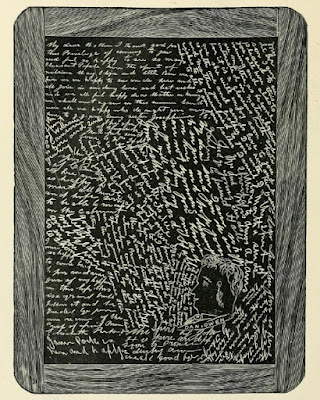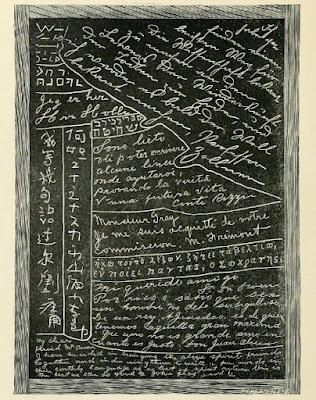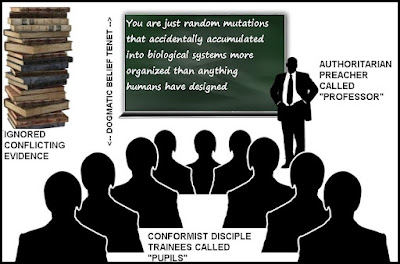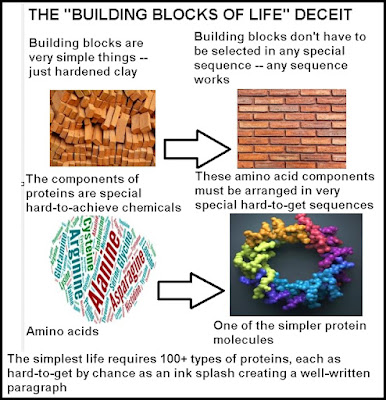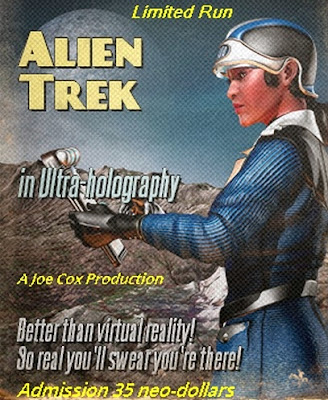In previous posts in this intermittently appearing "Spookiest Years" series on this blog (here, here, here, here, here, here, here, here, here, here, here, here, here, here, here and here) I had looked at some very spooky events reported between 1848 and 1880. Let me pick up the thread and discuss some spooky events reported in the years 1885 to 1889.
In the year 1885 the periodical Golden Gate had in its August 1 edition on page 4 a report of the phenomenon of slate writing, the mysterious appearance of writing on clean slates. A writer describes a visit to the home of a young medium named Fred Evans. We read this:
"Two slates were taken, and ...they were cleaned with a wet sponge and wiped dry, to show that they had not been prepared in any way. They were then placed together, with a number of bits of pencil between, and sealed with sealing wax at the edges, all under the supervision of a committee, of which the writer was one, and who placed a private mark upon each slate whereby he could not be deceived in the matter of their identification. The Committee then placed their hands upon the slates, along with those of Mr. Evans and Miss Hance. Soon the pencil tips were heard fluttering between the slates.. Mr. Evans then took the sealed slates and held them successively upon the shoulder of each person present. The writing could be heard almost instantly. Thus messages were written to every one present excepting two, including two messages to the writer, numbering fourteen messages in all, all written in different hands, and generally in facsimile of the writing of the persons they were supposed to represent. The messages were written in patchwork form all over the surface of the lower slate, some of them so small that they could be covered with a dime, and so finely written that they could scarcely be deciphered. Each message was a test of spirit identity to the person to whom it was written, and some of them were of a very surprising character. At the conclusion of the writing the seals were found intact, and were broken by the writer, the messages appearing within as stated."
The editor of the Golden Gate (James J. Owen) would eventually write a book on the mysterious slate writing observed in the presence of Fred Evans, a book that can be read online using the link here. On a page of that book we have an example produced in one of the sessions with Evans, where we see something matching the description above:
On page 16 of he book Owen says he had "had hundreds of experimental seances with this psychic [Fred Evans]." On the same page he recalls " one instance where some twelve hundred words were finely written over the surfaces of two large slates in what seemed to us an incredibly short space of time." On the same page Owen states this, "We have often, in his presence, sent out our thoughts to the spirit we would like to communicate with, and straightway the message would appear under our hands, and frequently in writing identical with that of the mortal whose spirit we had evoked."
In the next two pages Owen claims that Fred Evans was in touch with two spirits, one named John Gray, and another an artist spirit named Stanley St. Clair. On page 18 Owen states this:
"The frequent writing in colors that appears upon the slates, and that apparently without the use of colored crayons, is a most mysterious phase of this phenomenon. We have obtained as many as thirty-three shades of colors on a single slate. This color writing, we are aware, is not peculiar to Mr. Evans' guides alone, but we have never known a psychographist through whom the colors came in such great variety and profusion."
On the same page Owen states this:
"We called at the residence of Mr. Evans on Tuesday evening, December 27, 1892, when, under the usual crucial conditions, a personal message was written to the author, signed by eleven of his friends in spirit life, and all in different shades of color — some of them most delicate and exquisite. There were in all twelve shades of color upon the slate. The writing was produced under our own hands, no mortal hand touching the slate except those of the writer and his wife. The names and message are all of a personal character, but its chief merit to investigators is in the variety of colors, and the fact that they are written over a cross first placed upon the slate with a common slate pencil, to show that there was no false bottom to, or chemical preparation of, the slate, as jugglers or skeptics are disposed to assert."
On page 25 of the book we have this statement (signed by three witnesses) of seemingly paranormal events occurring in 1885:
"We, the undersigned committee, chosen by the audience at a public exhibition of independent slate-writing, given by Mr. Fred Evans at Washington Hall, on Sunday, June 21, 1885, testify that the slates used were washed and sealed in our presence and to our satisfaction, and during the time the slates were in use they were not removed from our sight. We distinctly heard the fragments of pencil between the slates writing, whilst holding them in our hands. When the writing was finished, which was denoted by three raps on the slates, Mr. R. B. Hall was selected by the audience to break the seals on the slates. When separated, one of them was completely covered with writing in patchwork form, embracing thirty communications, all in different handwriting. Each member of the Committee received messages signed by relatives or departed friends; the remainder of the messages was recognized by different persons in the audience. The exhibition was given in daylight before an audience of about 400 persons, and under conditions which excluded all chance of trickery or fraud.
Dr. Thos. C. Kellev, 946 Mission St.
Mrs. F. C. Lane, 3010 Folsom St.
William Kelly, 202 Second St."
On pages 28-29 of the book, we get an account telling us Fred Evans did very well in public tests of the slate writing phenomenon, tests held in San Jose, California before a large audience that included writers from newspapers. We are told that the San Jose News wrote up an account on March 14, 1887, and that the San Jose Times wrote up an account on March 15, 1887. I cannot find the editions for these dates, but would like to do so.
But on the front page of the May 8, 1886 edition of Golden Gate, we do have an account of a meeting with Fred Evans occurring on April 2, 1886. We are told the following:
"There were present at this seance fourteen persons in all, besides the medium and his wife. Six of those present were entire strangers to the medium, who also had no previous knowledge as to the proposed attendance of any members of the circle, with the exception of the writer and two others. There were no ballots written, and care was taken that the names of the strangers present should not be made known to the medium. Therefore no introductions were had; nevertheless, all present, except two, received messages upon the slate, some receiving two and three. The names given of the spirit friends of the persons unknown to the medium, is a most convincing test of spirit power.
The manner of the writing was as follows: A committee of two was appointed to see that the slates were properly cleaned and sealed. This was done first by thoroughly rubbing the slates with a damp cloth, and then, after placing a few minute bits of pencil between them, they were sealed together with sealing-wax at the edges. The committee then tied a cord around the slates and hung them to the gas jet in the center of the room. In a few moments the rapid moving of the pencil tips was distinctly heard, and in about four minutes light rapping announced that the writing was completed. The committee then removed the cord and seals, when the inner surface of one of the slates was found written over, as seen above."
The paper has the image below, which it says is a facsimile of what was found on a slate. The image is reproduced on page 50 of the Owens book. We are told Evans never touched the slate.
Owen states that on September 25, 1886 he observed a blank slate that seemed to mysteriously receive writing in more than nine different languages. We read this:" He [Evans] then handed the slate to us, and we (Mrs. Owen and the writer) were both fully satisfied that there was no writing upon the slate. From that moment the slate never left our hands, nor was it for an instant out of our sight. A small bit of slate pencil was placed upon the table, and we placed the slate over it, with our four hands resting thereon. Mr. Evans, sitting upon the opposite side of the table, touched the outer edge of the slate frame for a few moments, and then removed his hands entirely. In about five minutes loud raps signalled that the writing was finished. We raised the slate and found the under side covered as seen in the engraving."
We are told that the result was the slate shown below.
On page 45 we are given this translation of the writings:
"German — I have found an easy way for making known to science the proof of the return of the dead to this earth, and I shall soon give it to the world. Professor Zollner.
Italian— I am glad to be able to write you a few lines to aid in proving the truth of a future life. Count Rozzia.
French — Monsieur Gray. — I have acquitted myself of your commission. M. Fremont.
Greek — I come to say this — seek for better things — think well of all. Socrates.
Spanish — My Dear Friend, Sr. Don Orven: — Rich or wise as a man may be, don't let him be proud. It is from a King, Agesilaus, we have that grand maxim, 'that one is not great only as far as he is just.' Don Juan Alviso.
Norwegian— I am here. — Herr Holle.
Chinese — I write a few words for you. — Lu Yeun.
Japanese — How do you do? — Oyama Centura.
Hebrew — [This is a name of a book, describing the killing of animals according to the Jewish rites.]"
We are told on page 48 that the young Evans knew none of these languages.
On page 4 of the June 4 1887 edition of Golden Gate, we have an account of a session with Fred Evans that occurred only several days earlier, on May 27, 1887. We are told, "The most remarkable seance for independent slate-writing we ever witnessed occurred on Friday morning, May 27th, in presence of the eminent scientist. Dr. Alfred Russell Wallace, his brother, Mr. John Wallace, of Stockton, Dr. David Wooster, one of our leading physicians and a member of the Academy of Sciences, and the writer— four persons in all besides the medium, Mr. Fred Evans." We are told, "The slates were all thoroughly cleaned and examined by the brothers, and were, from, first to last, directly under their hands and sight." We are told, "All being done in the light and above board, with the slates in the hands of the investigator, there is not the slightest suggestion or possibility of deception." We have a quote from Alfred Russel Wallace saying, "I have never on any occasion witnessed phenomena of so wonderful a character appear with such rapidity and in a manner so entirely free from suspicion," and a quote from his brother saying, "I agree with the above remarks of my brother."
Pages 61-92 of Owen's book deals with a tour Fred Evans took (accompanied by Owen) throughout cities and towns of southern California in the spring of 1887. We read quite a few newspaper quotes by reporters who sound impressed after attending public exhibitions in which mysterious slate writing was witnessed in the presence of Evans, sometimes before an audience of hundreds. We are given this example of the mysterious output, which we are told was produced under test conditions under the direction of a committee. The figure depicted is Benjamin Rush, a figure in early American history. A person looking at the Wikipedia.org article on Benjamin Rush will see that the portrait and the signature are close to those shown in that article.
Later in the book we have an extensive account of Fred Evan's journey to Australia, where he underwent extensive testing before committees and audiences in places like Melbourne. On page 180 this impressive-sounding testimony is quoted:
"Melbourne, Victoria, Australia, May 8, 1889.
We, the undersigned, do hereby testify that we and each of us have investigated the phenomenon of independent slate-writing, occurring through the mediumship of Mr. Fred Evans, of San Francisco, Cal., U. S. A., and have obtained writing on the inner surfaces of slates that we and each of us have furnished ourselves, and which were not for a moment permitted to leave our sight.
The messages appearing thereon were always signed by the names of our departed relatives and friends, and information given that we are sure the medium could not have had any previous knowledge of whatever.
Whilst many of us are not Spiritualists, yet we and each of us agree that the messages appearing between our slates were placed there by some invisible intelligent power, independent of the medium.
SIGNATURES.
John Williams, Grain Dealer, Stock Street, Coburg, Victoria.
Edwin Gill, Justice of Peace, Balaclava, Victoria.
James T. Praagst, Government Land Office, E. Melbourne, Victoria.
R. Stewart, Esq., Bourke Street, Melbourne, Victoria.
Charles C. Bell, Esq., 4 Gordon Terrace, Mary Street, St. Kilda, Victoria.
John Carson, Esq., Kew, Victoria.
W. B. Rodier, Justice of Peace, ' Rougemont,' St. James' Park, Hawthorn.
John Henshaw, Manufacturer, Council Street, Clifton Hill, Victoria.
Thomas Martin, Manufacturer, 122 Rokeby Street, Collingwood, Victoria.
Richard Bond, Builder, Carpenter Street, Middle Brighton, Victoria.
Wm. Overton, Esq.
John Melville, Accountant, 24 Shiel Street, N. Melbourne, Victoria.
William Jackson, Builder, Armadale, Victoria.
E. Sharpe, Illawarra Road, Hawthorn, Victoria.
Daniel Clay, 33 Michael Street, N. Fitzroy, Victoria.
M. Bond, Middle Brighton, Victoria.
William Brown, 47 Napier Street, E. Melbourne, Victoria.
E. L. Melville, Shell Street, North Melbourne, Victoria.
E. Overton, Melbourne, Victoria."
On page 182 we have an equally enthusiastic testimony by an equally long list of named witnesses living around Sydney, Australia. The witnesses state, "We are satisfied that the manifestations of spirit or direct writing witnessed by us through your mediumship were beyond the possibility of fraud or deception."


